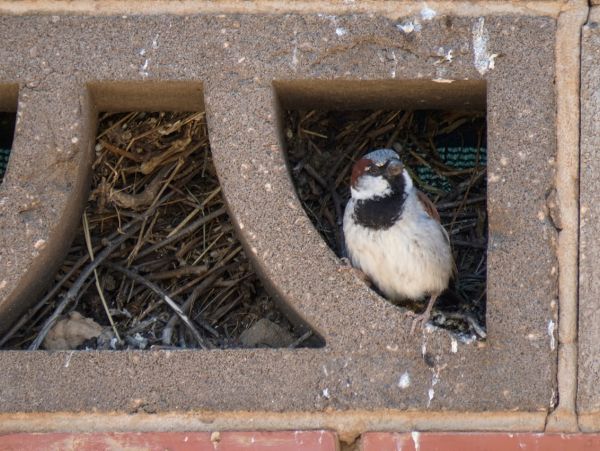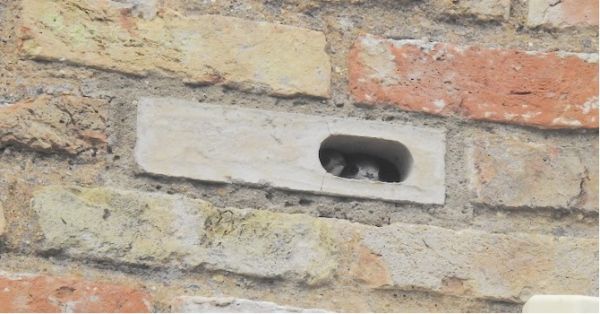Construction students at University College Isle of Man (UCM) have benefited from a course on safeguarding birds when building. Sophie Costain, Ecosystem Policy Officer with the Isle of Man Government, tells us more:
This month, Anna Graham, Education Manager for Manx BirdLife, delivered the first, of what we hope will be many, lessons to University College Isle of Man construction students on the topic of Birds and Buildings.
The lesson, developed by Manx BirdLife and the Department of Environment, Food and Agriculture's (DEFA) Ecosystem Policy Team, was inspired by the Manx Bat Group, which has delivered a similar annual lesson about Bats and Buildings to UCM construction students for many years.
The aim of both of these lessons is to provide emerging construction professionals with the relevant ecological knowledge to be able to identify nesting birds, and other wildlife that is reliant on our buildings, at different stages of their life cycles, so they are not unintentionally (or intentionally) disturbed, damaged or killed during building works.
It is important to note that both birds and bats are specifically protected under Manx law (the Wildlife Act 1990), and so awareness of legal responsibilities is a vital component of professional training.

(Photo: Griffiths Ecology Lab)
The lesson covered: when and where nesting birds can be found on, in and around buildings; what their nests look like; when to make checks for birds and the signs to look out for; the law that protects actively nesting birds; what species nest in our buildings; what to do if nesting birds are found; and how to avoid and mitigate impacts.
From big messy nests made of twigs built on top of our houses, to small nests in gaps around our roofs, to delicate mud nests underneath eaves or on top of covered ledges, our beautiful bird compatriots have nests of all shapes and sizes which are built in a variety of different places. Big and small properties, old and new, on top of, inside of, in vegetation on the side, and even in places such as post boxes and sheds.
But why should the students and we care?
· As noted, it is the law: wild birds that are actively nesting, as well as their nests, eggs and chicks are legally protected under the Wildlife Act 1990.
· They need our help: at least 20 of the Isle of Man’s wild bird species regularly breed on, in or around buildings and other structures. Some of these, including Swifts, are entirely reliant on buildings for nesting. Others species are red-listed in the Isle of Man and the UK, meaning that they are of highest conservation concern. Therefore, the need to ensure that birds are considered before, during and after works, and wherever possible, are enabled to continue breeding on these sites, is essential.
· They are a beautiful and much loved part of our Biosphere’s built heritage. Birds have adapted to live with and alongside us for millennia, and have the right to remain and thrive.
· Seeing and hearing birds in our local environment is also great for our wellbeing and can positively impact our mental health.
But it is not just the responsibility of construction industry professionals to take account of birds when undertaking works. Property owners, tenants, agents and managers also need to be aware of and take account of nesting birds when planning works – the law applies to us as well.

(Photo: Swift Conservation)
So what can you do?
· Consider nesting bird season in your own planning. It happens at the same time every year, from March to August, so just as springtime is a busy time for our activities, it is also for birds. (Noting that some species nest outside of these dates – eg house martins into September and pigeons in winter).
· Check around your building for signs of nesting birds, and take steps to ensure that nesting birds are not impacted by building works. This may include delaying works until birds have finished nesting.
· Obtain advice from the DEFA Ecosystem Policy Team if you have any queries regarding nesting birds, or if you are planning on undertaking works on a structure that you know, or suspect has, or has previously had, nesting birds.
· When you can, make sure that the building work is undertaken in such a way that allows birds back into their nest spaces once work is finished. If this is not possible provide them with alternative nest sites by installing new nest ledges, nest boxes or nest bricks. But remember, different species of birds use different types of space, so you will need to use the right nest box for the species of bird in your building. If you’re unsure, get some advice. The Ecosystem Policy Team and Manx BirdLife are happy to help.
· Even if you do not have nesting birds on your property, you could consider erecting bird boxes or bricks anyway to increase nesting opportunities in your local area.
Swifts for example, are a quintessential sign of British summertime and are often seen soaring over rooftops on late summer evenings, with their dark sickle-shaped wings and distinctive ‘screaming’ calls. Unfortunately, swift nest sites have been and continue to be lost when buildings are demolished or refurbished. Because swifts are faithful to their nest site, their breeding success is being severely affected and their numbers have declined. But you could help change their fortunes simply be providing them with nest bricks or boxes. All you need is a willing mind and a tall building (nests need to be at least 5m above the ground).
Visit Manx BirdlIfe, too, to take Action for Swifts on the Island.
So keep in mind your bird (and bat) boarders, don’t evict them unnecessarily and do what you can to help them thrive. Let us build a world with more birds, not fewer.
Contacts:
Ecosystem Policy Team: 01624 651577, ecopolicy@gov.im
Manx BirdLife: 01624 861130, enquiries@manxbirdlife.im
Manx Ornithological Society: jthompson@manx.net
Main photo: Paul Stevens


